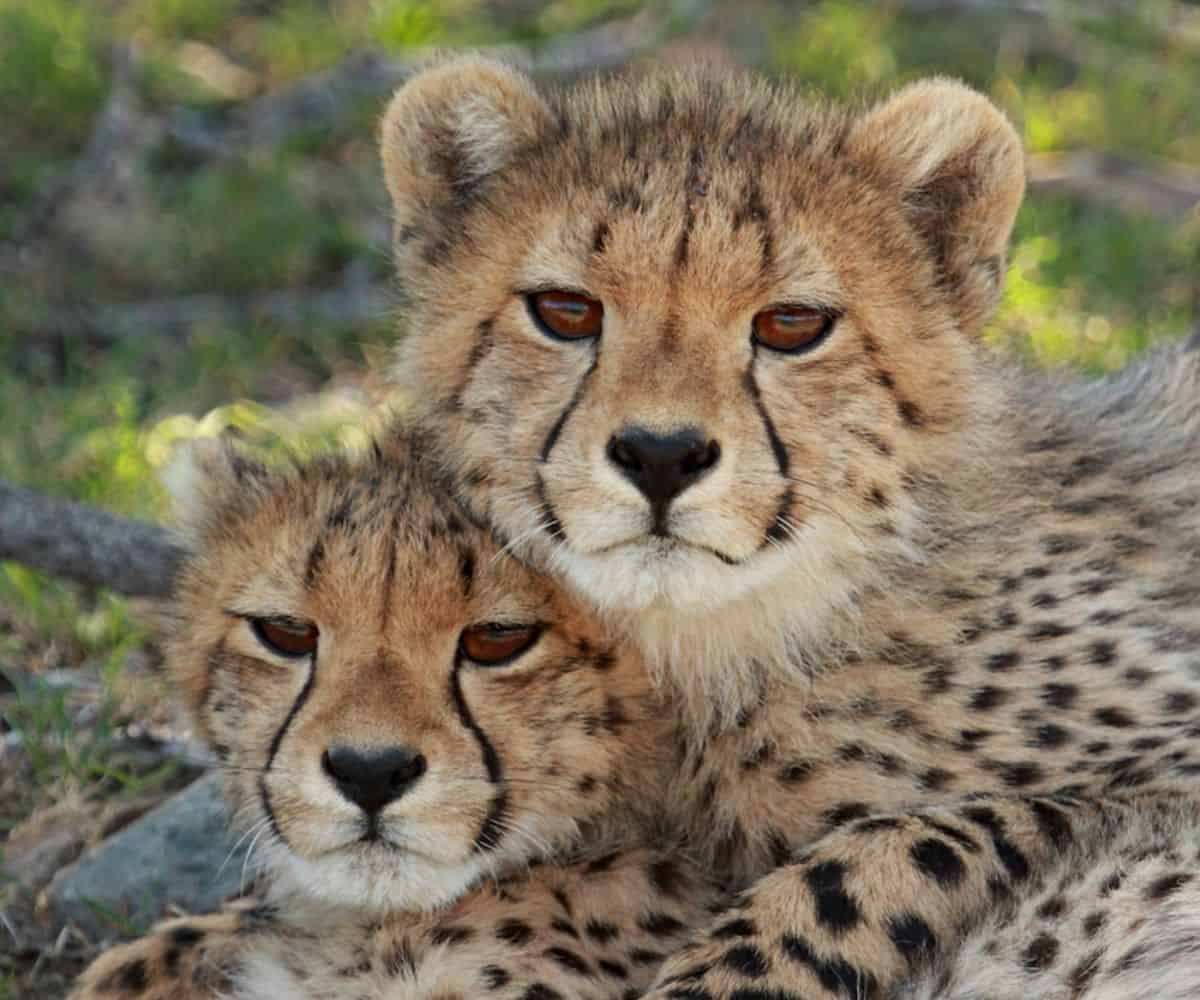Although I don’t own a cat, I have to say that I am fascinated by them and their alluring feline beauty, their playful nature and expressive communication.
We once took in two gorgeous Tomcat kittens, each with a stunning coat, the colour of marmalade, with dark ginger streaks, they had little white cheeks and white socks and I felt compelled to make drawings and paintings of them but I was so busy taking care of them, I opted to photograph them, knowing that those photographs would be lovely to work from later.

Boy, they were fast when at play and full of amusing antics, one was cheeky, mischievous and craved attention, the other, quite shy and timid, would hide behind the other.
Alas, my eldest daughter and I reacted quite considerably to their dander and they had to go back to the kind cat loving lady who had rescued them.

It was such a shame as our fox red Cocker Spaniel Obi was getting used to having them around. I still have ideas for illustrating stories about the two of them getting up to allsorts of adventures with our 3 dogs and I’m delighted that, for the purpose of this article, I have started to draw and paint them.
Cats in Art History
Before you begin your journey into drawing and painting cats, you might be inspired by looking a little into the history of cats represented in Art practice, painting and sculpture throughout time.
Many cultures throughout the ages have held cats and the image of cats in high regard. For instance in Ancient Egypt, cats were worshiped as a symbol of home, fertility and protection. In Japanese folklore, the ‘Maneki Neko’ or beckoning cat is a popular symbol of good luck and prosperity.
Edward Manet 1832 – 1882 produced some really lovely, simple sketches of cats, achieving their curled sleeping positions and playful antics in just a few pencil strokes.
You can enjoy spending some time looking at examples and why not take a look at my Pet Portraits page. Gathering ideas and knowing what styles appeal to you will certainly help and inspire you to have some fun creating your own cat inspired artwork.
Getting Ready to Create
Drawing a cat may seem daunting at first, but with a little guidance on where to start and some tips on techniques to try, you’ll soon be feeling more confident about drawing and even having a go at painting cats.
With just a little practice you will find your own style of capturing their stunning eyes, wonderful whiskers and their soft fur as well as your cat’s elegant poise.
Here are some of my sketches for you to take a look at before we start.
For these examples, I have used my favourite combination of Art materials, I love to work in watercolour, pen and ink with a little pencil work in there too.

With my drawing style being quite illustrative, I like to think that I capture the essence of an animal, in this case, cats, with realistic proportions by using simple techniques and at the same time, adding some cute details and a sense of fun and personality to the drawings.
I often start with painted washes even when working in monochrome shades and I enjoy adding fine detail with fine line pen or a very slim tipped paint brush.
Materials You Will Need
It is important when drawing anything to start by working with something that you feel comfortable with or inspired to experiment with!
You may wish to start your sketch in pencil but feel inspired to go straight into paint. In this case, why not start with a very pale wash of paint just like I often do. It helps distract from the fear of a blank sheet of paper staring back at you.

Here is my recommended list of things to have to hand for starting to experiment with drawing cats:
- HB pencil
- 2B 3B 6B pencils are optional
- Paintbrushes (round tipped Winsor and Newton Colman range are great for beginners)
- I recommend a size 10 or 12
- A smaller size for fine detail size 4 or 5
- Paper 250gsm allows you to use a mix of media
- Watercolours – Winsor and Newton Cotman Sketchers 13 piece sketchers set is a favourite with me for getting started as well as taking out and about
- Fine tip pens – Uni Pin Fineliner set 0.1mm, 0.5mm and brush tip set
- Fine tip white Gel Pen
- Pencil crayons – Derwent or Winsor and Newton offer a wide variety of colouring pencil sets for you to choose from and to suit all pockets.
I favour Derwent Inktense colouring pencils and also their Watercolour pencils that can be blended with water, they are great for achieving the soft effect of fur.
Sketching the Basic Shapes
If we look at the image below, you will see that I have simplified cats in different postures into simple shapes.

To begin with and for the purpose of this step by step guide, I recommend working from photographs of cats or images that you find online or in a magazine. This will allow you time to really look at the shapes that the cat’s body, head, paws, ears and tail are making and give you the knowledge and confidence and the speed to later work from life.
You can take the time to study where the cat’s eyes sit in proportion to the rest of its face, notice how its ears sit and the different shapes that it forms with its body and its tail.
Have a practice at creating the different shapes that can be used to form the structure of your cat. The shapes that you need to have a go at drawing are:
- Circles and ovals of different sizes
- Triangles
- Cylinders
- Diamonds
Why not refer to my examples in my article ‘How to draw a dog’ to help you.
Forming the Head
The head of a cat typically fits a circle or oval depending on the position the cat is in. This will change a little depending on whether they are mid movement, stretching and posing or sleeping.
Decide whether your cat’s face fits a circle or an oval shape best.
Body
The cat’s body can be formed using a circle, a cylinder or a triangular shape.
Study the position and posture of your cat, are they sleeping and all curled up with their body forming a circle, or are they all stretched out, forming an elongated oval?
If your cat is seated and upright in a proud posture, the best shape to choose will be a triangle.
Positioning the Legs
A cat’s legs are wider at the top, where the bone and muscle join onto their body, the hind legs have hips attached and so a triangle can be used as a basic shape.
A cat’s forelegs (front legs) are slim with elbows at the top. On a cat, we call their joints ‘ stifle joints ‘
Circles or ovals can be used to mark out and position where their paws sit in different poses, you can see how I have used a variety of sizes on the cats I have drawn in the image above, depending upon what pose the cat is forming.
Positioning the Tail and Ears
You can use a simple, curved line to plan out where the cat’s tail sits.
The position of a cat’s tail reveals a lot about their mood and also their intentions. If you are drawing a cat that is all curled up in a relaxed sleeping position, it is likely, its tail will be wrapped around the outer edge of its body in a curve, signifying comfort and rest.
If your cat is at play in your drawing, it may have its tail up and curled at the end in a question mark formation, a sign that your cat is feeling happy, friendly and inviting interaction.
Your cat’s ears can be marked out and simply formed using triangular formations. Depending on whether your cat is looking directly at you or away in one direction, its ears may appear equal in proportion or you can base them on triangles of different sizes.
Here I have rounded the edges of the triangles on the cat that is facing us. The left ear is slightly larger as the cat is looking face on but its head is slightly tilted towards us and its right ear is a little smaller.

In the image on the right, the cat has its back to us. It is looking slightly left and so the left ear is again closer to us and is larger. You can see that I have used a much smaller triangle to form its right ear.
To mark out this cat’s tail, I have drawn a simple line that curves around from the centre of its back towards the left side of its body.
Refining the Outline
Once you have established the basic outline and shape of your cat’s form using the painterly technique of watercolour or using the more structured technique of building up shapes, you can start to sketch in the actual outline of your cat.
Soften the lines, use gentle curves and think about the flesh, muscle and fur that make up the form of your cat.
Also soften the outer edge of your cat’s face. Shape the cheeks softly, noticing where they are at their fullest. Cats have cute little fur covered chins, add this in at the bottom of your initial circle.
You will see in the image below that I have used a sharpened HB pencil to draw the outline softly and to shape the ears and on the cat facing us. I have started to draw in its paws and legs and started to add its facial features.

Defining The Facial Features
So, you have formed the basic shape of your cat’s head using a circle or an oval shape depending on its stance and positioning and you have softened the edges of your drawing.
Looking closely at the example I have drawn for you below, you will see that before drawing in the features of my cat, I drew three straight lines that divide up my cat’s face. You don’t have to use a ruler to draw these, free hand is best and you can even curve them slightly if you wish.

The first line that you need to lightly draw, is a line that runs down through the very centre of your cat’s face, from the top of its head to the bottom of its chin.
Next, you need to draw in an eye line. This line runs across the face of the cat and is positioned halfway between the top of its head and the bottom of its chin.
Then you can draw a line that runs across your cat’s face and is half way down between the eyes and the chin. The point where this line crosses the centre line is where your cat’s nose will sit.
Eyes
You will notice that the cat’s eyes are based upon an outer oval shape, with a circular form for the coloured iris inside and sitting inside that is its pupil.
A cat’s pupil is a vertical slit that we often think of and associate with cat’s eyes, this can expand to a wide round opening in dim light and contract to a narrow slit in bright light.
A cat’s pupil will also change size and shape in response to emotion, much like our human pupils can.
Also, similarly to when we plan to draw human eyes, the space between the cat’s two eyes is the same width as one of its eyes.
Look closely at the angle of the cat’s eye that you are drawing. I like to draw one eye first and then plan the space across the cat’s nose (which will be the width of that first eye) and then, I draw in the second eye, taking care to achieve the same angle.
If you are drawing or painting your cat in colour, it is crucial to identify the lightest point in your cat’s eye and to draw in shapes of light in its eye. Leave these shapes white, you can gently add colour to them later or even use white paint to accentuate them and give life and character to them later.
Look closely at the colour of your cat’s iris. Use the darkest tone of colour on the outer edge of the iris, look for patterns formed and shade very lightly towards the pupil.
Cats tend to have a dark, almost black outer edge to their eyes. Try to choose dark shades of colour and avoid black. This will help to give tone and shade and realism, again without heaviness. If you go too dark too soon, you will find yourself with nowhere to go, my advice here is always build gradually. Choose lightest and darkest points first and create shade in between.
It is very important to keep any white that can be seen around the outer edge of the cat’s iris, if you are using paint, you can emphasise this further with pure white and then soften the effect with a light shading of pencil crayon.
Always remember that your cat’s eye is curved, try to blend and shade with this in mind, curving your shading towards the outer edge.
Also, once you have finished creating your cat’s eye, you can use a bright white dot of paint or white fine line pen to add a dot of light or shapes of light.
There are many similarities in the principles of drawing and shading an animal eye to drawing and shading a human eye. Take a look at my article ‘How to draw and eye’ for further tips and guidance.
Nose
As we have already said, your cat’s nose can be based upon a triangular shape.

- Start with a triangle and add a centre line down its middle.
- Either side of this triangle, draw a small right angle towards the middle line of the nose.
- Now draw a semi circle that sits on top of that right angle, this will form your cat’s nostrils.
- Draw the top line of your cat’s nose, you can make this really light on your drawing as it is where fur meets nose and it may not be very defined on your cat. The line has an upward curve either side of the centre line, forming a dip in the middle.
Mouth
I would imagine that to begin with, you are going to be drawing a cat with its mouth closed, drawing its jaw open can come later in your cat drawing journey and I will explain this in an additional article.
We call the area of a cat’s mouth a muzzle. Cats have fur covered cheeks that meet in the middle beneath their nose.
Their cheeks are soft, rounded ovals and they have small chins that sit just below them. As we mentioned before, you can draw your cat’s chin as a soft curve that sits in the middle, below their cheeks and join it to the fullest part of its cheeks on either side.
Shaping the Ears
The ears of your cat started as two triangles. Notice if one is tipped more forwards, if they look equal in size or need adjusting and now soften the edges.
If your cat is face on, you will also need to draw what you can see of the pale pink inside of your cat’s ear.
Cats have soft hairs and fur that lines the pink of their ears. Don’t try to draw each and every hair, your drawing or painting will easily become too heavy. Instead, remember, less is more, go steady with darker tones and where hairs are white and soft, have something at hand like a white fine line gel pen or a nice thin tipped brush to help you achieve these.
Texturing the Fur
There are lots of creative ways to approach drawing fur and achieving a soft, smooth coat and a realistic texture.

In the images above, I have used watercolour, the kitten laying down has a simple wash of colour, a first layer of the ginger coat. I have used a painterly technique, starting to add a tiny bit of form to its head and body.
Whereas on the kitten turning his head towards us, I have mixed up deeper ginger tones to create his stripy markings and to give pattern and form to his head. He isn’t finished, I have left him with just one coat of watercolour paint so that you can see how adding additional layers would make his fur more realistic whilst helping to further shape his body. We call this ‘form’

Once you have added subtle tones and layers of watercolour to achieve a cat’s coat, you can work in sharpened pencil crayon and gradually add layers of texture.
Work with your pencils in one direction and where the cat’s body curves, try to curve your pencil in that direction.
When it comes to building layers of fur, go carefully and tentatively. If you wish to incorporate more definition, this is where fine line ink pens come in.
Ink pens can be use to give a stronger outline, deeper definition and more character to your cat’s coat, face, legs, tail and paws.
If you are working illustratively or creating a fun, cartoon cat, you can go as bold as you wish, if you are set on creating a realistic interpretation of the cat or kitten you are studying, this is where you will need to work in carefully applied layers, studying how the cat’s coat tones change as they follow the contours of its body.
Incorporating Whiskers
When it comes to adding whiskers on any animal, less is more. Although a cat’s whiskers add a cute dimension and character to a cat drawing or painting, remember that they are very fine, long, stiff hairs that are highly sensitive, they help cats to navigate their way around, to hunt and to access their environment.
Cats typically have 12 whiskers on each side of their muzzle (on their cheeks) . These whiskers are arranged in four rows.
You can use tiny dots of pencil to represent the tiny holes where the whiskers come out of the fur or a fine line pen. Don’t try to represent all 12 whiskers as this can appear too heavy. You will notice that I have only included 5 whiskers on either side of the cat’s face in the next illustration shown below.
Take your pencil, fine line pen or a thin paint brush. Starting at the follicle, flick your media from the cat’s cheek outwards, creating an ark.
Cats’ whiskers are often darker towards the follicle and become more translucent as you work outwards. You might wish to use a white gel pen to achieve the lightest tips of your cat’s whiskers.
Shading and Highlights
To complete your cat and give your artwork additional character and form, you can add in any shadows formed by your cat’s stance. Notice how I have added shadows cast onto the surface where my cats are seated in the studies below.
You can also add shadows under the cat’s chin and on its belly. Go steady and add shadows gradually, you don’t want to over dominate your painting or drawing but adding shadows will add form and character, or even accentuate your cat’s posture.
Adding gentle shadows will also emphasise where the light hits your cat’s body and help to give a sense of realism.
When painting shadows, use colour, mix up tones that compliment your work. Avoid using black, this will make your work too heavy.
Remember that cats and kittens are very light on their feet and so shadows that are cast need to be kept light and elegant.

Conclusion
Now that you have experimented with building a drawing or drawings of your cat step by step, you may wish to have a play and experiment to find your drawing style.
As I say, my drawing style is quite illustrative, especially when it comes to drawing animals. I love to think of my drawings gracing the pages of story books and I think this naturally comes across in my work.
You may wish to polish your technique and master the art of recreating your cat in such detail that is absolutely life-like, we call this type of art ‘Photorealism’
Or, you may wish to take your work in the opposite direction and develop a cartoon style for your cat drawings and studies.
You can start your cartoon studies the same way that we approached our cat studies in this article. It is helpful to start by establishing simple shapes that make up your cat. You then have a framework to build your cartoon features around.
Cartoons are a lot of fun to develop as there are no set rules and you can go to town exaggerating the features of your cat, such as enlarging the eyes, ears, tail and paws or even its stance and positioning.
When it comes to adding colour to your cat, you can go bold and quirky using whatever colour you choose and you could exaggerate the cat’s markings, you can create really unique characters getting up to all sorts of cat capers and mischief.
I hope that you have enjoyed this article and that your journey with drawing and painting cats has begun. Look out for further tips and articles on mastering specific features and the fur of animals.
I would love to hear from you, do let me know how you get on.



















 English (US) ·
English (US) ·